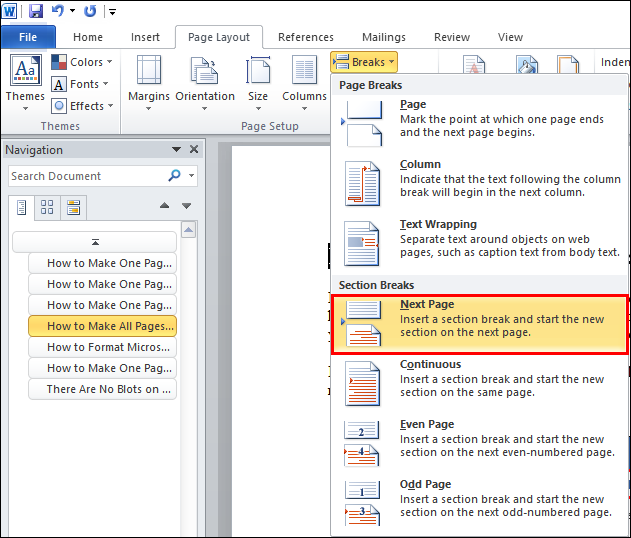

As you might guess, you now need to create another section break, and then return the rest of the document to portrait mode. However, if you scroll through your document, you’ll notice that all the pages following that section break you created are now in landscape mode. Change page-number orientation and other header and footer elements when switching between portrait and landscape layouts in Word 2003, 2007, and 2010. You now have successfully switched your new section to landscape mode. This time, click the “Orientation” button, and then click the “Landscape” option. Your cursor should now be at the top of the page in your new section-the page you’re changing from portrait to landscape. You will notice that an extra space was added at the top of the page that you are re-orienting. While it’s not obvious, the action you just took created a section break where your cursor was placed, and started your new section on the next page. Then, under Orientation, click on the box that says Landscape. On the Layout tab, click the “Breaks” button, and then select the “Next Page” option on the dropdown menu. Step 3: Click the Orientation button in the Page Setup section of the ribbon, then choose the Landscape option. On the Margins tab, click Portrait or Landscape as orientation. Select the pages or paragraphs that you want to change to portrait or landscape orientation. Step 2: Click the Page Layout tab at the top of the window. To employ both portrait or landscape orientation in the same Microsoft Word file: 1. Step 1: Open your document in Microsoft Word.
HOW TO APPLY LANDSCAPE ORIENTATION IN WORD HOW TO
Next, switch to the “Layout” tab on the Word Ribbon. If you use Google Docs, then this article will show you how to change this setting as well. You can create the section first, and then insert the page if you want.įor example, if you want page 31 to be landscape-oriented, place your cursor at the end of page 30. We’re assuming that you’ve already got the page you want to be landscape oriented in your document. In your document, place your cursor at the very end of the page right before the page that you want to be landscape-oriented. So first, you’ll need to create a separate section in the document (even if it’s just for one page), and then you’ll need to change the page layout for that new section to landscape orientation. These resources contain complete instructions on how to email or. Word’s page layout features apply to whole sections of the document, and by default, your document is one large section. Thats because the preview in that window is of an invoice in landscape orientation. Unfortunately, you can’t just tell Word to reorient the page. Occasionally, you’ll want to include one or more landscape-orientated pages.


Word documents are portrait-oriented by default, which makes sense. Create a Landscape Page in a Portrait-Oriented Word Document


 0 kommentar(er)
0 kommentar(er)
